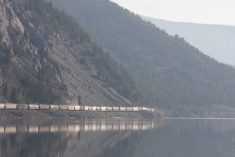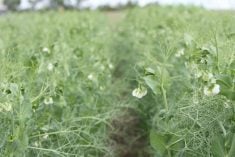STE. ROSE, Man. – The future of farming seems bright to Rob Brunel, a 29-year-old farmer who is dedicating his life to agriculture.
And that goes for other young farmers in the area.
“Everybody’s fairly optimistic,” he said, taking a break from a day of spraying quackgrass patches in a perennial ryegrass field.
“Maybe we’re na•ve, but I don’t think so.”
Brunel, who is chair of Keystone Agricultural Producers’ young farmers committee, said problems in farming, such as the BSE situation, don’t seem insurmountable.
Read Also

Prairies have variable soil moisture conditions
The dry weather in the west was welcome for preserving grain quality and advancing harvest, but it has resulted in very dry soil moisture conditions.
“You just have to work through them,” he said.
Brunel’s farm lies at the extreme northern end of the cropland that spreads across North America. A few kilometres north the clumps of trees show the transition from cropland to range and forest land. It’s a beautiful location, with the dark mass of Riding Mountain National Park visible to the southwest, Lake Dauphin to the west and over the eastern horizon, Lake Manitoba.
Brunel may be young, but his family has a long legacy in the area. Great-grandfather August first brought the Brunel name to the Ste. Rose area from France. Grandfather Jean-Louis, who is 85, is still involved with his sons’ farms.
Rob and his father, Paul, operate a farm together, as do his uncle and cousin. The two wings of the family operate separate farms, but they share some equipment, which has made it easier for each family.
“We partner up on some of the bigger items so that we can share,” said Brunel.
Coping with BSE
He has been around farming all of his life, so he has been able to take the BSE problems in stride. He and his father have looked at it as a management problem, not a tragedy. They have a herd of Simmental-Angus cross cows and they are debating their future.
“Dad and I thought about divesting our herd and focusing on the grain land, but with the capital we have invested in it, you want to make sure you can take something out of it.
“But if we’re going to spend money on anything, it’ll be on the grain side.”
Rob is not keen to get out of cattle entirely.
“It’s not as enjoyable working with the cattle (because of BSE) but I still like it.”
He and his father farm about 2,000 acres, growing wheat, oats and canola as well as some grass seed.
Since the 1970s the Brunels have structured their farm as a corporation, which Rob said has made it easy to operate and adjust ownership stakes.
“You’re not transferring land so much as moving shares,” he said.
Brunel has been living in the same building that houses the farm’s office, but he and his chocolate Labrador, Georgia, are getting ready to move onto a new yard site where he has set up a house trailer.
“I’m ready for my own yard,” he said.
Rob went to the University of Manitoba for a diploma in agriculture. It gave him a lot of knowledge about farming but also provided a network of colleagues and experts whom he still relies upon for advice.
He’s hoping KAP’s young farmers group can create the same sort of network. Quebec’s young farmers, he said, have a good organization and they helped set up the Manitoba young farmers. Now the Manitobans are hoping to set up the same thing in Saskatchewan.
This October, Brunel’s group is organizing a young farmers conference in Brandon, which he hopes will give young farmers a chance to meet others.
In March, Rob attended a U.S. young farmers conference in Nebraska, which he said showed him that young farmers can help each other by comparing experiences.
“We all face the same challenges starting up and getting going,” said Rob.
Deciding on a career in farming wasn’t something he ever had to do.
“Ever since I can remember, I wanted to farm. That’s what I wanted to do. That’s what I love doing.”















